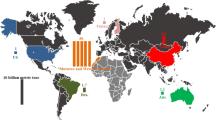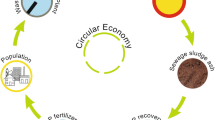Abstract
Phosphorus (P) is essential to all life being and a key ingredient in fertilizers to sustain high crop yields. It is an indispensable nutrient for food production and in a world of 9 billion people by 2050, securing sufficient P will be critical for future food security. Phosphorus has no substitute, but can be continually reused, being an example of a critical resource that could be utilized more efficiently in a circular economy to support sustainable growth and decrease pollution sources. Electrokinetically based technologies can be effective and viable options for P recovery from sewage sludge. In this work, chemometrics was used to develop a multivariate model based on 13 previously reported electrodialytic experiments (ED) of sewage sludge. The model predicted P recovery based on the experimental variable: cell design, time, current density and sewage sludge properties. The model showed that the cell design, current density and time highly influenced P recovery. Accounting the best recovery percentage achieved in the studies used for the model, 70% in 3 days using 0.21 mA/cm2, ED technology has the potential to recover 280,000 tP/y of the total P in the sewage sludge. A strengths, weaknesses, opportunities, and threats analysis of EK technology for P recovery was also performed and several advantages were identified. For example, depending of the reactor design, the installation of whole electrokinetic treatment system may be adapted to the current wastewater treatment plants reactors decreasing the installation costs. One of the main identified threats to P recovery technologies is the lack of EU-level phosphorus legislation. But the presence of cost-effective alternatives to increase its recovery could be a driver towards an effective political/socio-economical implementation.




Similar content being viewed by others
References
Cordell, D., Rosemarin, A., Schröder, J.J., Smit, A.L.: Towards global phosphorus security: a systems framework for phosphorus recovery and reuse options. Chemosphere 84, 747–758 (2011)
Schröder, J.J., Cordell, D., Smit, A.L., Rosemarin, A.: Sustainable use of phosphorus. Plant Research International, Wageningen University and Research Centre. Report 357. EU Tender ENV.B.1/ETU/2009/0025 (2010)
Smith, S.R.: Organic contaminants in sewage sludge (biosolids) and their significance for agricultural recycling. Philos. Trans. R. Soc. Lond. A 367, 4005–4041 (2009)
Withers, P.J.A., Elser, J.J., Hilton, J., Ohtake, H., Schipper, W.J., van Dijkf, K.C.: Greening the global phosphorus cycle: how green chemistry can help achieve planetary P sustainability. Green Chem. 17, 2087–2099 (2015)
Chowdhury, R.B., Moore, G.A., Weatherley, A.J., Arora, M.: Key sustainability challenges for the global phosphorus resource, their implications for global food security, and options for mitigation. J. Clean. Prod. 140, 945–963 (2016)
Acar, Y.B., Alshawabkeh, A.N.: Principles of electrokinetic remediation. Environ. Sci. Technol. 27, 2638–2647 (1993)
Jensen, J.B., Villumsen, A.: Method and apparatus for the decontamination of products containing heavy metal, Patent PCT/DK95/00209 (1995)
Ottosen, L.M., Jensen, P.E., Hansen, H.K., Ribeiro, A., Allard, B.: Electrodialytic remediation of soil slurry–removal of Cu, Cr, and As. Sep. Sci. Technol. 44, 2245–2268 (2009)
Jensen, P.E., Ottosen, L.M., Ferreira, C.: Electrodialytic remediation of soil fines (<63 µm) in suspension-Influence of current strength and L/S. Electrochim. Acta 52, 3412–3419 (2007)
Ottosen, L.M., Jensen, P.E., Kirkelund, G.M., Hansen, H.K.: Electrodialytic remediation of different heavy metal-polluted soils in suspension topical collection on remediation of site contamination. Water Air Soil Pollut. 224, 1707 (2013)
Ottosen, L.M., Hansen, H.K., Laursen, S., Villumsen, A.: Electrodialytic remediation of soil polluted with copper from wood preservation industry. Environ. Sci. Technol. 31, 1711–1715 (1997)
Ribeiro, A.B., Pinus, C., Mateus, E.P., Ottosen, L.M., Bech-Nielsen, G.: Electrodialytic removal of Cu, Cr, and As from chromated copper arsenate-treated timber waste. Environ. Sci. Technol. 34, 784–788 (2000)
Hansen, H.K., Rojo, A., Ottosen, L.M.: Electrodialytic remediation of copper mine tailings. Procedia Eng. 44, 2053–2055 (2012)
Ottosen, L.M., Lima, A.T., Pedersen, A.J., Ribeiro, A.B.: Electrodialytic extraction of Cu, Pb and Cl from municipal solid waste incineration fly ash suspended in water. J. Chem. Technol. Biotechnol. 81, 553–559 (2006)
Ottosen, L.M., Pedersen, A.J., Hansen, H.K., Ribeiro, A.B.: Screening the possibility for removing cadmium and other heavy metals from wastewater sludge and bio-ashes by an electrodialytic method. Electrochim. Acta 52, 3420–3426 (2007)
Pedersen, K.B., Kirkelund, G.M., Ottosen, L.M., Jensen, P.E., Lejon, T.: Multivariate methods for evaluating the efficiency of electrodialytic removal of heavy metals from polluted harbour sediments. J. Hazard. Mater. 283, 712–720 (2015)
Jensen, P.E., Ferreira, C.M.D., Hansen, H.K., Rype, J.U., Ottosen, L.M., Villumsen, A.: Electroremediation of air pollution control residues in a continuous reactor. J. Appl. Electrochem. 40, 1173–1181 (2010)
Pazos, M., Kirkelund, G.M., Ottosen, L.M.: Electrodialytic treatment for metal removal from sewage sludge ash from fluidized bed combustion. J. Hazard. Mater. 176, 1073–1078 (2010)
Mateus, E.P., Zrostlíková, J., Da Gomes Silva, M.D.R., Ribeiro, A.B., Marriott, P: Electrokinetic removal of creosote from treated timber waste: a comprehensive gas chromatographic view. J. Appl. Electrochem. 40, 1183–1193 (2010)
Ottosen, L.M., Jensen, P.E., KIirkelund, G.M., Ebbers, B.: Electrodialytic separation of heavy metals from particulate material. Patent PCT/EP2014/068956 (2016)
Guedes, P., Magro, C., Couto, N., Mosca, A., Mateus, E.P., Ribeiro, A.B.: Potential of the electrodialytic process for emerging organic contaminants remediation and phosphorus separation from sewage sludge. Electrochim. Acta 181, 109–117 (2015)
Guedes, P., Mateus, E.P., Almeida, J., Ferreira, A.R., Couto, N., Ribeiro, A.B.: Electrodialytic treatment of sewage sludge: current intensity influence on phosphorus recovery and organic contaminants removal. Chem. Eng. J. 306, 1058–1066 (2016)
Paz-Garcia, J.M., Johannesson, B., Ottosen, L.M., Ribeiro, A.B., Rodriguez-Maroto, J.M.: Modeling of electric double-layers including chemical reaction effects. Electrochim. Acta 150, 263–268 (2014)
Sturm, G., Weigand, H., Marb, C., Weiß, W., Huwe, B.: Electrokinetic phosphorus recovery from packed beds of sewage sludge ash: yield and energy demand. J. Appl. Electrochem. 40, 1069–1078 (2010)
Cordell, D., Drangert, J.O., White, S.: The story of phosphorus: global food security and food for thought. Glob. Environ. Chang. 19, 292–305 (2009)
P-REX project: Phosphorus recycling—now! Building on full-scale practical experiences to tap the potential in European municipal wastewater, Policy Brief. http://p-rex.eu/uploads/media/P-REX_Policy_Brief_final.pdf (2014). Accessed June 2017
IFA: Feeding the earth: global phosphate rock production trends from 1961 to 2010—reasons for the temporary set-back in 1988–1994, Feeding the Earth Series. http://www.fertilizer.org/ (2011). Accessed June 2017
Carpenter, S.R., Bennett, E.M.: Reconsideration of the planetary boundary for phosphorus. Environ. Res. Lett. 6, 14009–14012 (2011)
European Commission: Towards a circular economy: a zero waste programme for Europe. Communication from the Commission to the European Parliament, The Council, the European Economic and Social Committee and the Committee of the Regions, COM(2014) 398 final. http://cor.europa.eu/en/activities/stakeholders/Documents/COM(2014)%20398%20final.pdf (2014). Accessed June 2017
European Commission. Report on critical raw materials for the EU, Report of the ad-hoc working group on defining critical raw materials. European Commission, Raw Materials Supply Group (2014)
Bright, D.A., Healey, N.: Contaminant risks from biosolids land application: contemporary organic contaminant levels in digested sewage sludge from five treatment plants in Greater Vancouver, British Columbia. Environ. Pollut. 126, 39–49 (2003)
Sartorius, C., Von Horn, J., Tettenborn, F.: Phosphorus recovery from wastewater—expert survey on present use and future potential. Water Environ. Res. 84(4), 313–322 (2012)
Rajasulochana, P.: Comparison on efficiency of various techniques in treatment of waste and sewage water—a comprehensive review. Resour. Technol. 2, 175–184 (2016)
Cieślik, B., Konieczka, P.: A review of phosphorus recovery methods at various steps of wastewater treatment and sewage sludge management. The concept of “no solid waste generation” and analytical methods. J. Clean. Prod. 142, 1–13 (2016)
Ebbers, B., Ottosen, L.M., Jensen, P.E.: Electrodialytic treatment of municipal wastewater and sludge for the removal of heavy metals and recovery of phosphorus. Electrochim. Acta 181, 90–99 (2015)
Devi, P., Saroha, A.K.: Utilization of sludge based adsorbents for the removal of various pollutants: a review. Sci. Total Environ. (2016)
Kirkelund, G.M., Magro, C., Guedes, P., Jensen, P.E., Ribeiro, A.B., Ottosen, L.M.: Electrodialytic removal of heavy metals and chloride from municipal solid waste incineration fly ash and air pollution control residue in suspension—test of a new two compartment experimental cell. Electrochim. Acta 181, 73-81 (2015)
Mitchell, C., Fam, D., Cordell, D.: Effectively managing the transition towards restorative futures in the sewage industry: a phosphorus case study. In: Howe, C., Mitchell, C. (eds.) Water sensitive cities, pp. 83–96. IWA Publishing, London (2012)
Acknowledgements
Authors would like to thank AdP for the collaboration. Financial support was provided by UID/AMB/04085/2013 and N. Couto acknowledges Fundação para a Ciência e a Tecnologia for her Post-Doc fellowship (SFRH/BPD/81122/2011).
Author information
Authors and Affiliations
Corresponding authors
Rights and permissions
About this article
Cite this article
Guedes, P., Couto, N., Mateus, E.P. et al. Phosphorus Recovery in Sewage Sludge by Electrokinetic Based Technologies: A Multivariate and Circular Economy View. Waste Biomass Valor 8, 1587–1596 (2017). https://doi.org/10.1007/s12649-017-9985-y
Received:
Accepted:
Published:
Issue Date:
DOI: https://doi.org/10.1007/s12649-017-9985-y




